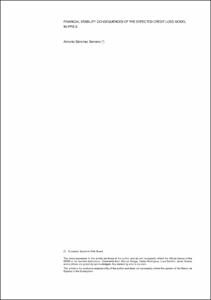Registro completo de metadatos
| Campo DC | Valor |
|---|---|
| dc.contributor.author | Sánchez Serrano, Antonio |
| dc.date.accessioned | 2020-04-02T12:13:42Z |
| dc.date.available | 2020-04-02T12:13:42Z |
| dc.date.issued | 2018-05 |
| dc.identifier.uri | https://repositorio.bde.es/handle/123456789/11273 |
| dc.description | Artículo de revista |
| dc.description.abstract | Following the G20 mandate, there has been a move from incurred loss approaches for the recognition of credit losses to expected credit loss approaches. Since 1 January 2018, European banks follow the approach defined by IFRS 9, according to which, exposures are allocated to three stages depending on their relative credit risk. These stages require different time horizons for the computation of expected credit losses and different basis for interest accrual. Overall, the timelier and fuller recognition of credit losses is expected to bring substantial benefits to financial stability. However, IFRS 9 is not going to be applied with perfect foresight. On the contrary, expected credit loss models would be able to anticipate downturns only shortly before their occurrence. At the onset, a system-wide sizable increase in provisions associated with expected credit losses can be expected, which may have undesired procyclical effects via banks’ profits and regulatory capital. The paradigm shift in accounting for credit losses may call for a policy reflection on: i) the importance of supervisory stress tests; ii) a call for simplicity in models; iii) the need for better and harmonised disclosures; iv) the expectations on the use of cyclical capital buffers, and v) the interaction with the current regulatory framework. |
| dc.format.extent | 19 p. |
| dc.language.iso | en |
| dc.relation.ispartof | Financial Stability Review / Banco de España, 34 (May 2018), p. 77-95 |
| dc.relation.hasversion | Versión en español 123456789/11252 |
| dc.rights | Reconocimiento-NoComercial-CompartirIgual 4.0 Internacional (CC BY-NC-SA 4.0) |
| dc.rights | In Copyright - Non Commercial Use Permitted |
| dc.rights.uri | https://creativecommons.org/licenses/by-nc-sa/4.0/deed.es_ES |
| dc.rights.uri | http://rightsstatements.org/vocab/InC-NC/1.0/ |
| dc.title | Financial stability consequences of the expected credit loss model in IFRS 9 |
| dc.type | Artículo |
| dc.identifier.bdebib | 000362061 |
| dc.identifier.bdepub | FIER-2018-34-077 |
| dc.subject.bde | Normativa contable |
| dc.subject.bde | Contabilidad financiera |
| dc.subject.bde | Regulación y supervisión de instituciones financieras |
| dc.subject.bde | Riesgos y liquidez |
| dc.publisher.bde | Madrid : Banco de España, 2018 |












